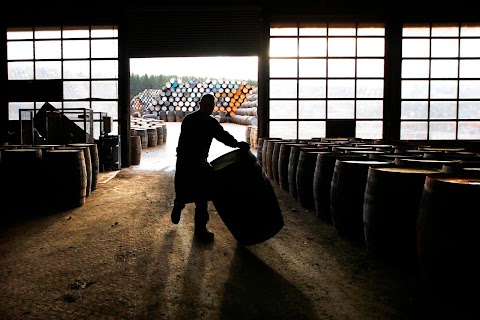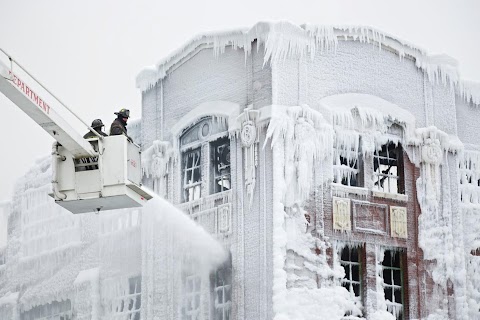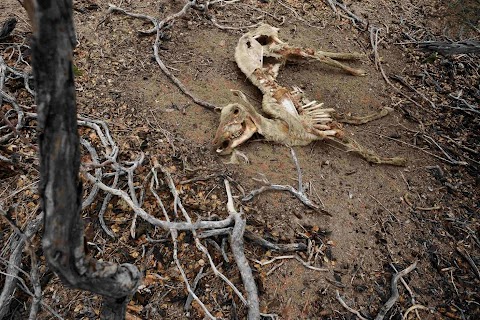
Barrel of fun
 David Moir
David Moir
A workman rolls a whisky cask for repair at the Speyside Cooperage in Scotland, where they've been fixing and making traditional oak casks since 1947.
Scotch whisky has become Scotland's largest international export, ahead of even refined petroleum. The country exported some 40 bottles per second in 2011.
Slideshow

Colourful oak whisky casks are piled high at the Speyside Cooperage.

A workman, known as a cooper, pushes a barrel by a colourful mountain of casks, piled up like rolls of thread.

Coopers work side by side repairing oak casks. They repair and build up to 150,000 casks a year.

A cooper checks the circumference of a whisky barrel lid during repair. Each worker is paid per cask, working on 20 to 30 per day.

It’s a very busy working environment, there is no room for small talk or lazing about.

A cooper rolls a whisky cask along the floor before starting the process to repair it.

A workman lifts a barrel in front of a pyramid of casks.

A stow of bourbon casks from the United States, including Jack Daniels and Jim Beam, is stored at the Speyside Cooperage.

A half-cask filled with wood shavings and tar, known as a Clavie, is set alight during the Burning Of The Clavie festival. This ancient Scottish custom from the 1700's is still observed in some parts and receiving a piece of the burning Clavie is said to bring good luck for the coming year.

A copper sculpture of a Highland stag sits atop a weather vane at the the Glenfiddich scotch whisky distillery.

Glasses of scotch whisky sit on a table during a tour of the Glenfiddich distillery.
"One thing still remains the same. The old oak casks."
Scotch whisky is big business. Global sales have reached well over 5 billion pounds per year with demand still growing in countries where previously whisky was far from the tipple of choice.
Drinks companies have been eager to quench that thirst, building huge computer-run distilleries all over the world to increase production.
But one thing still remains the same. The old oak casks.
Whisky isn’t Scotch Whisky unless it has been distilled in Scotland and matured for a minimum of three years in an oak cask which comes in various capacities from a Pin to a Butt. The tradesmen who build and repair the oak barrels, known as coopers, have passed the skills down through the generations and show no signs of entering the hi-tech world. They still use traditional tools such as a dowelling stock, flagging iron, inside shave and a hollowing knife.
I visited the Speyside Cooperage which started as a family business in 1947. It is situated in the small village of Craigellachie in the north of Scotland - affectionately known as the Malt Whisky Trail. They repair and build up to 150,000 oak casks a year, with each ‘cooper’ still being paid per cask, working on 20 to 30 per day like it always has been. The hardest workers can earn up to 60,000 pounds per year.
It’s a very busy working environment with no room for small talk or lazing about. Cooper’s earn their crust from the moment they roll a cask to a workspace, begin taking it apart, hammering the lid, metal hoops and inspecting the wooden staves. They then make the repairs and put it back together again. It’s pretty much “perpetual motion”, a phrase used by Andrew Russell, the general manager of the cooperage.
Outside the cooperage's main building are rows (or stow’s) of oak barrels delivered from around the world. Stacked high in the air with the different distillery names stamped on the lids, it’s a formidable sight.
Among the barrels are U.S. bourbons like Jack Daniels and Jim Beam as well sherry and port barrels from Spain and South America. It’s like a holiday brochure of countries you want to visit and shows how a local company in the north of Scotland can remain a crucial part of the global market through traditional methods and a hard work ethic .
From the water in the hills, via the distillery's copper still, to the oak cask where it may sit for up to fifty years until it is finally tasted – it’s perpetual motion. I couldn’t put it any better myself.
Slainte!














